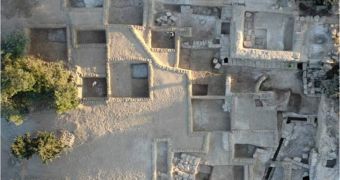In a new discovery, archaeologists in Israel have found the ruins of an ancient garden, which was the symbol of power in the old days. Having the power over water in the desert was a clear indicator that you were somebody.
The structures date back to the 7th century BC, experts say, and feature complex irrigation systems of the type that were only seen in the Hanging Gardens of Babylon, in Mesopotamia.
Experts from Germany and Israel found the ruins, and began excavations a few years back. Since then, students have been helping the efforts, which uncovered a large portion of what once was an impressive hangout spot for royalties and high officials.
Due to its geographical position, the gardens could be seen from three directions, exposing its owners for the rich, powerful and influential people that they were. The structure are located very close to Jerusalem, LiveScience reports.
The site is currently handled by investigators at the Tel Aviv University and the Heidelberg University, in Germany. The location is called Ramat Rachel, and it is a Israeli communal farm.
The scientists say that this si the first ever structure of this type to be found intact and ready for exploration in the country. “We have uncovered a very rare find,” TAU archaeologist Oded Lipschits says.
The very size of the place is amazing. In a country that had a large desert, and where water was praised above nearly everything else, the elite afforded to spend their leisure time chilling inside lush, green gardens.
In addition to the structure themselves, the researchers also discovered traces of the irrigation system the gardeners attending the spot used to keep water flowing to the plants.
It featured both opened and covered channels, complete with stone-carved gutters. According to the research team, the gardens may have also had several artificial waterfalls, which was something amazing in itself.
“It is our assumption, due to a combination of our finds at the dig correlated with historical texts, that the garden and the main parts of the citadel were constructed during [the period when Judah became a vassal of the Assyrian empire], and probably following some kind of 'order' of the empire, or at least to facilitate the needs to raise taxes to it,” Lipschits explains.
Judeans most likely built the initial gardens, which remained in use between the 7th and 4th centuries. This was a hard time for Israel, as numerous wars were fought in the area back then.
Regardless, the gardens always stood at the end of the day, and the new owners would always contribute to its expansion and improvements.
“The abundance of stamped jar handles, a form of administrative-economic system, from the Assyrian, Babylonian and Persian periods, indicate the site was in use throughout the changing of powers,” the expert adds.
“The lack of destruction layers suggest the transition went smoothly in Ramat Rahel, and that it continued with its original purpose – an administrative center of produce distribution,” he goes on to say.
Researchers now want to conduct even more studies in the area, as they hope the location will shed more light on the political intricacies and turmoil that permeated the area where the gardens stand.
In a paper that will appear in an upcoming issue of the journal Near Eastern Archeology, the team writes that future investigations will also include analysis of the plant remains found at Ramat Rahel.
The plaster that lines the walls of the irrigation channels will be scanned for traces of pollen, which researchers say will give them some insight into where the soils used in the gardens originated from.
“Proper excavation will provide an essential tool to future researchers. We are carefully deciphering what we have in front of us. There are no parallels to it,” concludes TAU graduate student and study researcher Boaz Gross.

 14 DAY TRIAL //
14 DAY TRIAL //